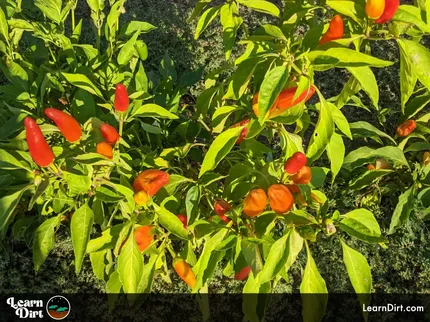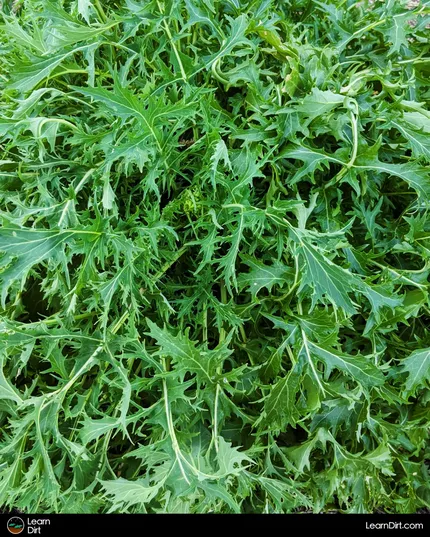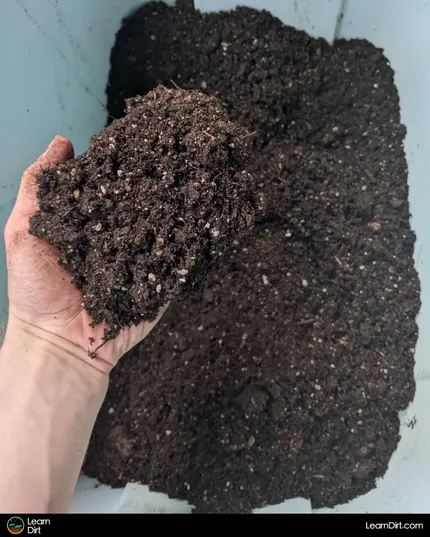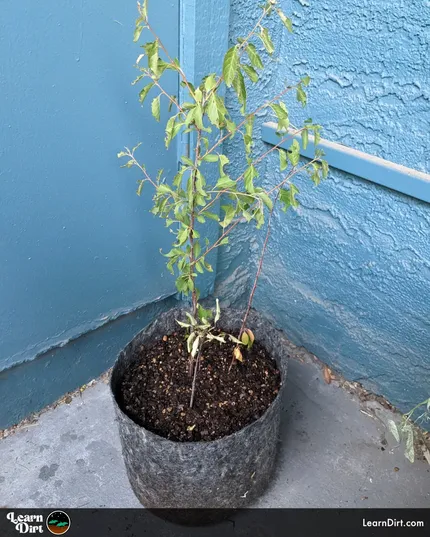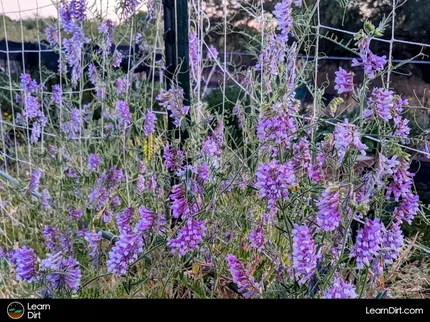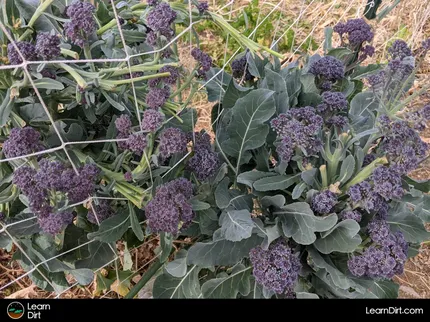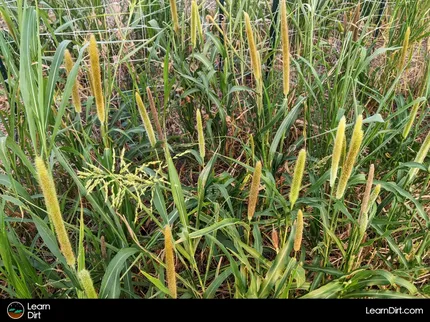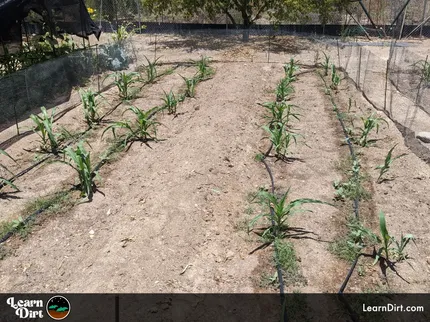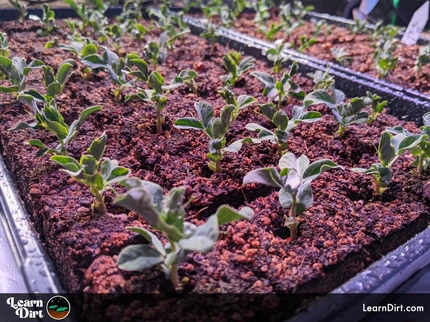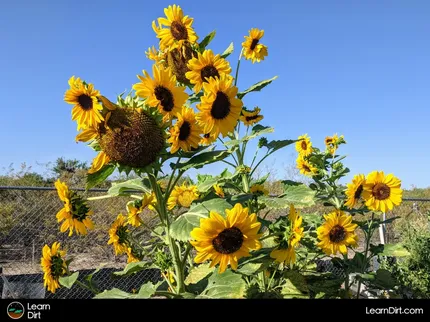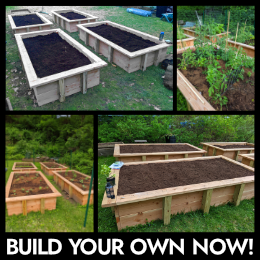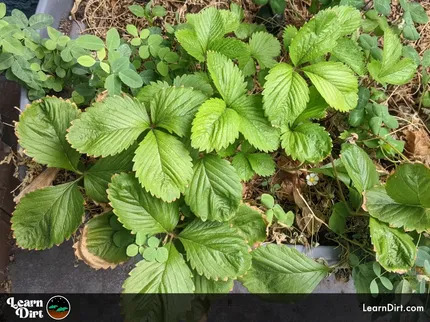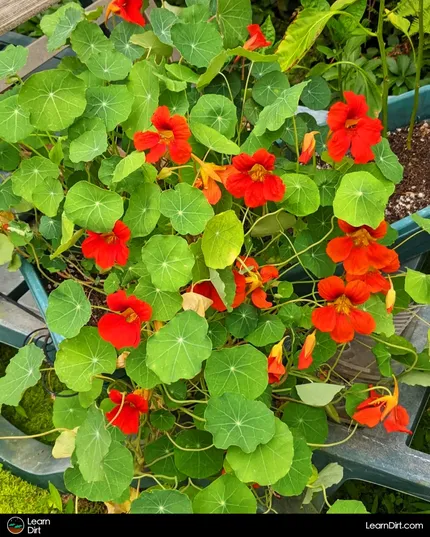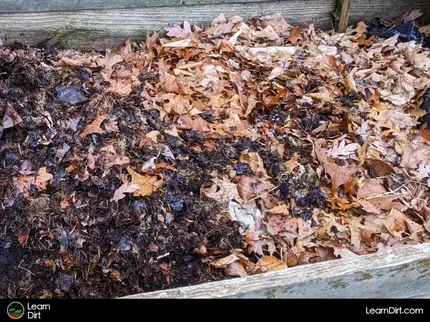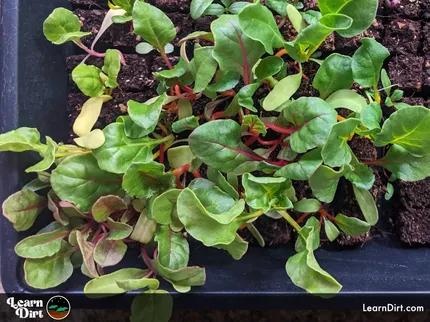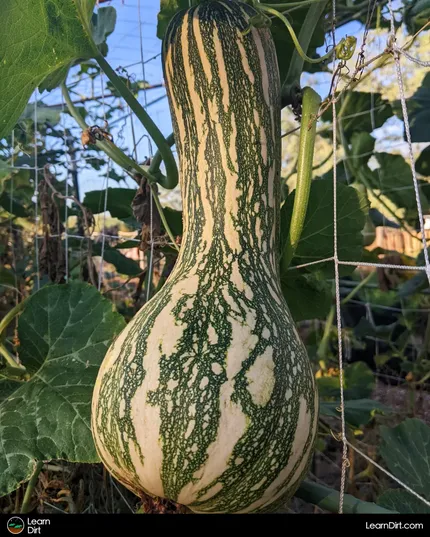Table of Contents
- Cucumber Seedlings
- Transplanting Cucumbers
- How to Grow Cucumbers in Pots
- Using a Trellis for Cucumbers
- How Do You Trellis Cucumbers
- Fertilizing Cucumbers
- Common Cucumber Pests
- FAQs
* Our articles never contain AI-generated slop *
Cucumbers are a little different than other members of the squash family (cucurbitaceae). Let's look at what they need and how to plant them.
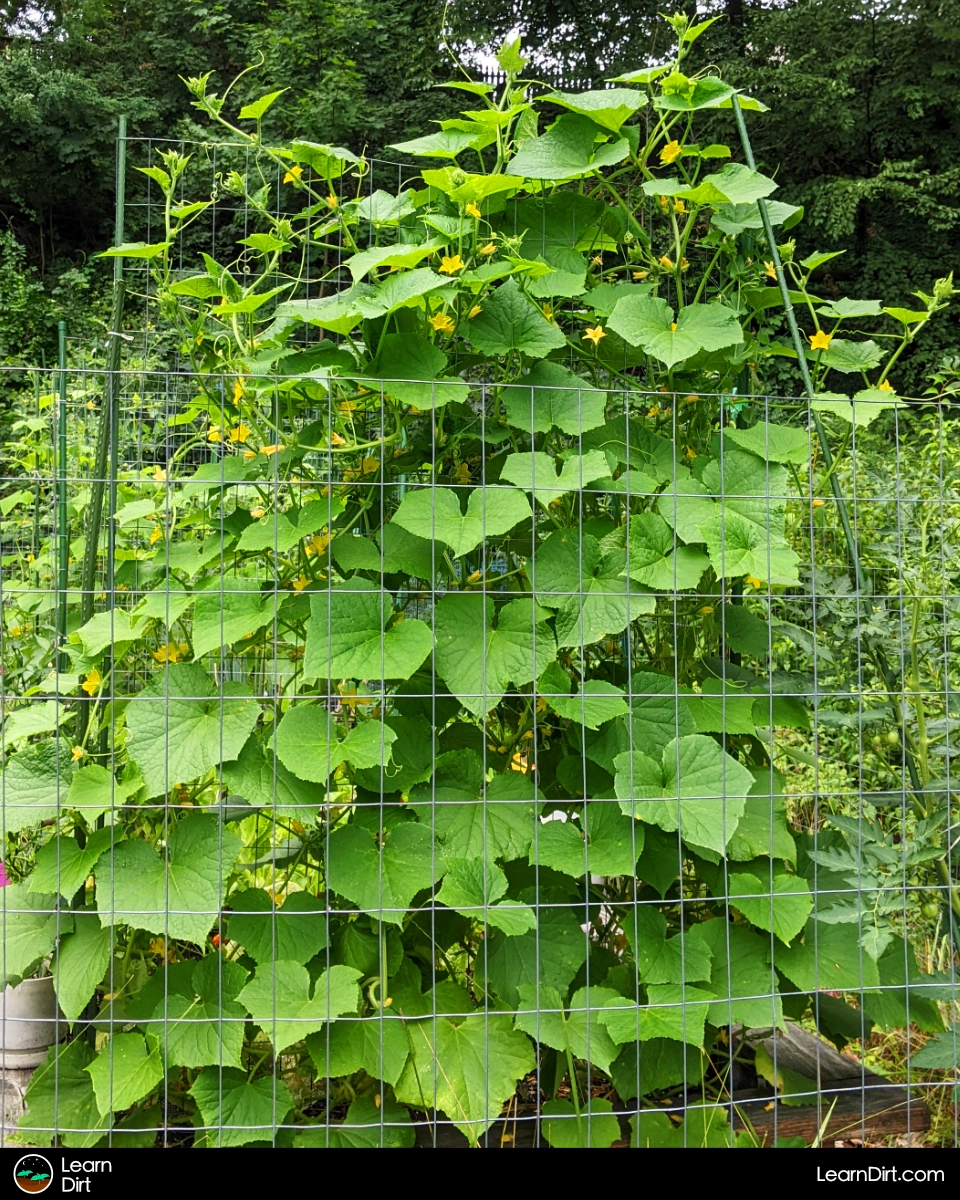
Cucumber Seedlings
Cucumbers are a great plant to start from seed because they grow so quickly and don't need much babying.
A few weeks in small planters under grow lights, on the window sill, or in your greenhouse can give you a great jump on the season without much effort needed.
Disclaimer: This post may contain affiliate links. Refer to the privacy policy for more information.
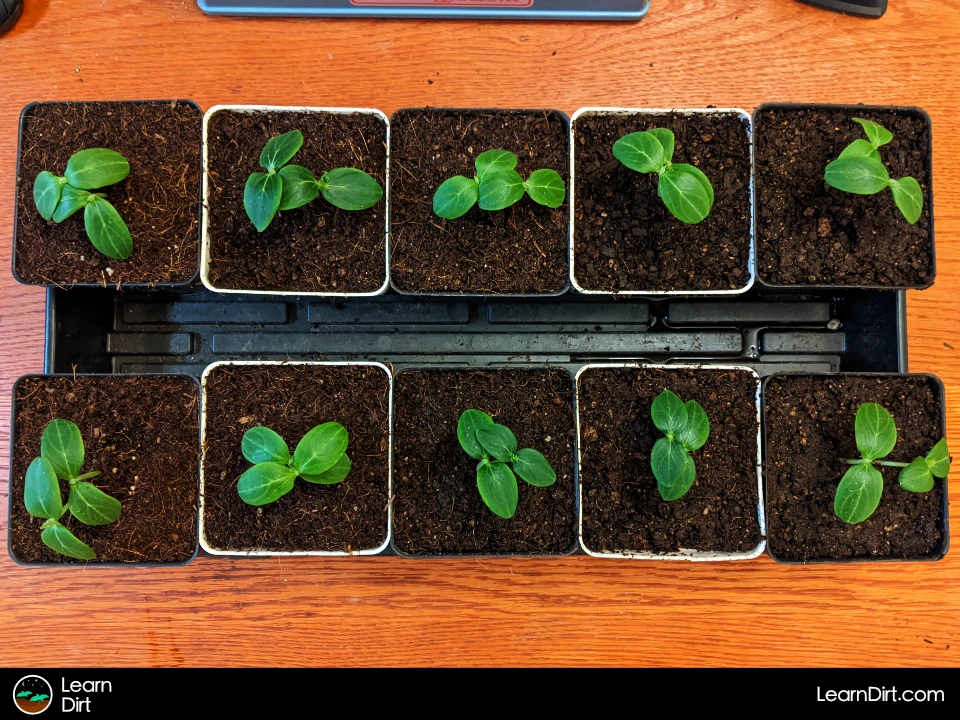
How Do You Plant Cucumber Seeds?
Cucumber seeds do not need light to germinate, and will sprout just fine in the dark as long as you get them into the light promptly after the start to sprout.
Choosing a Container to Start Cukes In
You can start cucumber seeds in 2x2x2-inch soil blocks, but they'll rapidly outglrow them and need to be transplanted into 4x4x4-inch blocks or out to the field within a couple weeks.
You can also sow cucumber seeds in 4x4x4-inch nursery pots right from the get-go, which is what I've personally started doing. Check it out:
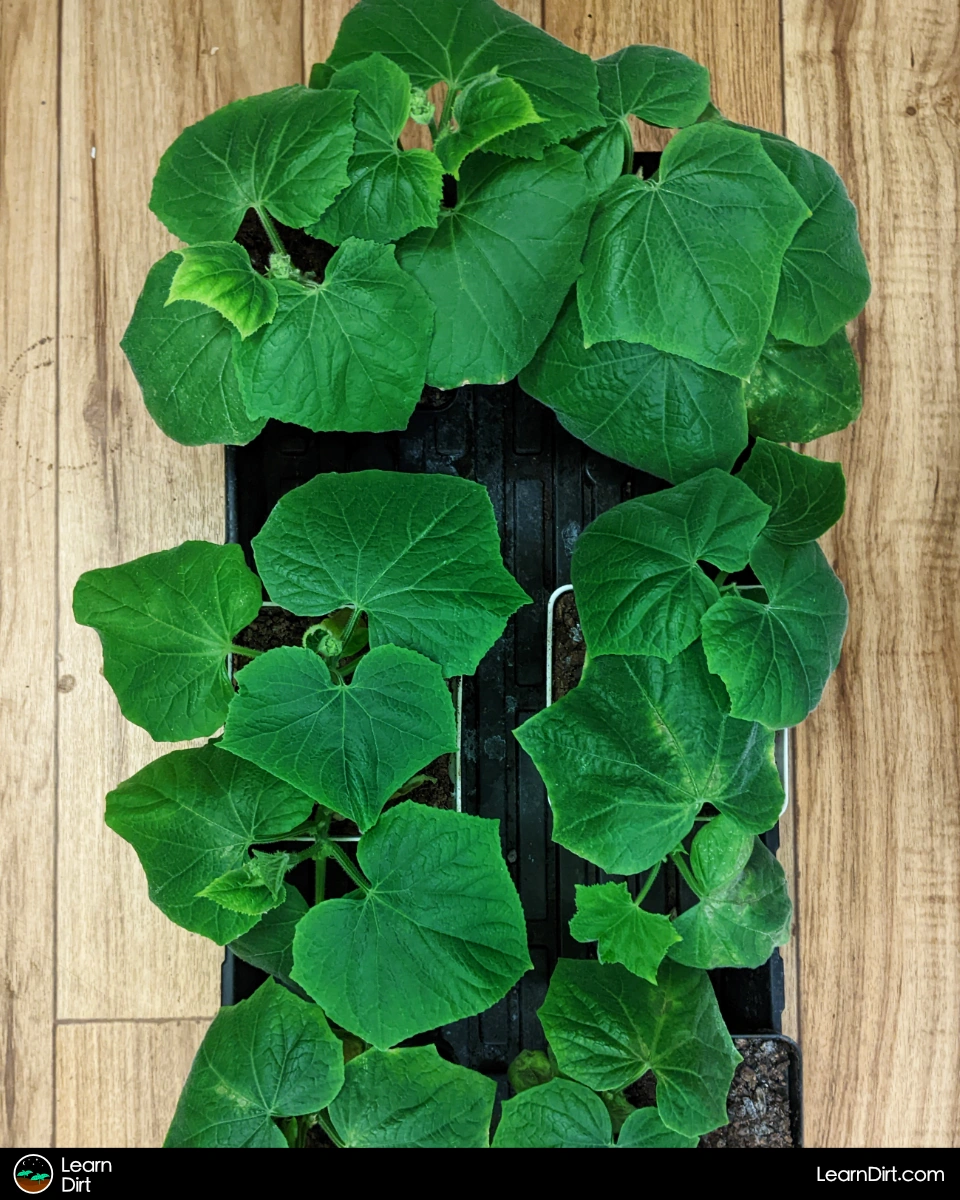
I highly suggest against starting your cucumbers in cell packs, which are typically only 1x1x2-inch - cucumbers will outgrow them so quick it's werth it to just go bigger straight away.
Sowing Cucumber Seeds
Plant cucumber seeds about 1-2 inches deep (2.5-5cm). They can push their way through a lot of soil and aren't very picky as long as they're buried.
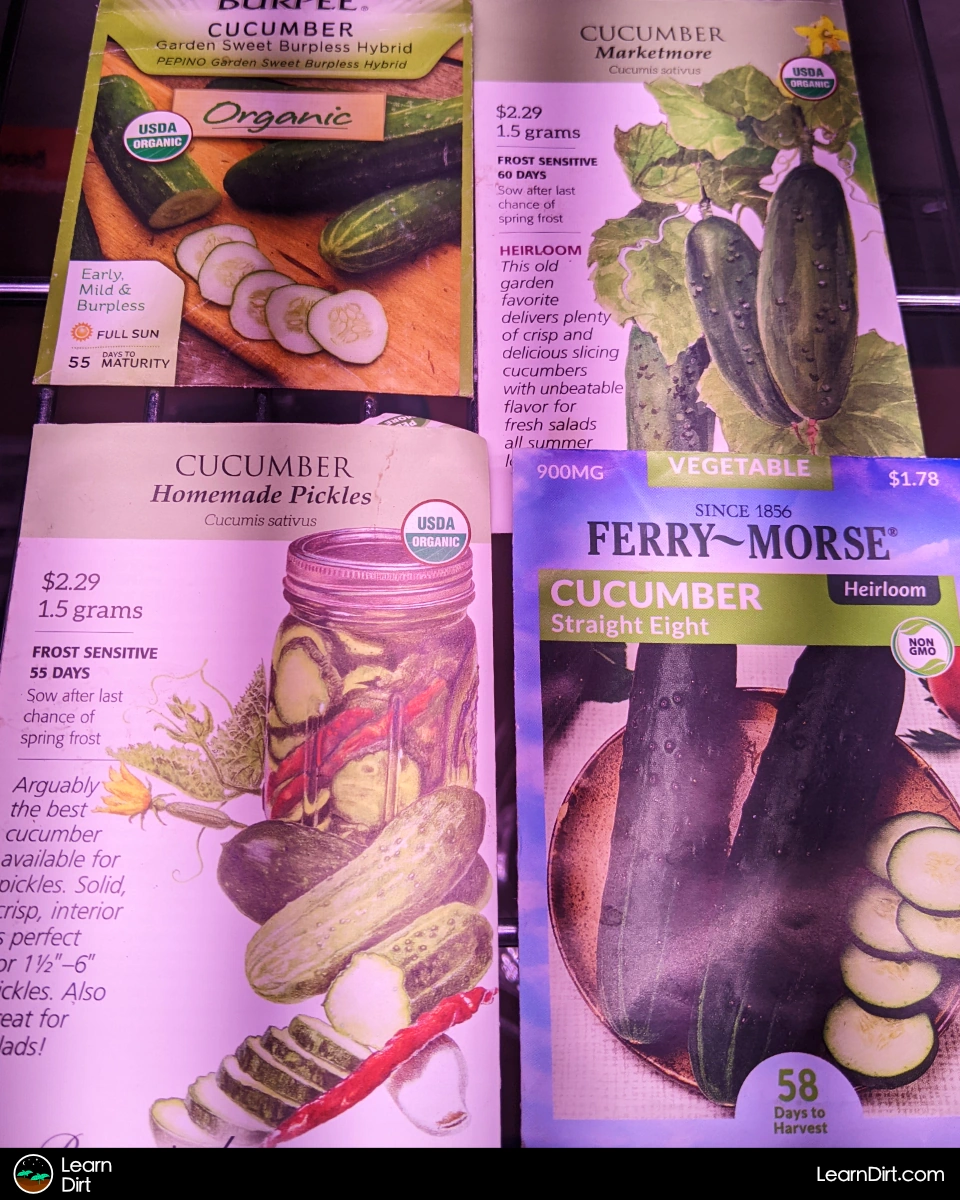
How Long for Cucumber Seeds to Germinate?
You'll usually wait about 7-10 days for cucumber seeds to germinate, depending on the variety and how fresh the seeds are.
Join The Grower's Community
Whether you cultivate vegetables, house plants, succulents,
mushrooms, flowers, cannabis, or more...
you're welcome here 🌱
Check It Out!
If you're behind on your planting, you can cut a few days down from the germination time by clipping the pointy end (radicle) of cucumber seeds to allow moisture to permeate the seed faster. Nail clippers work great for this - just clip no more that 1mm to avoid damaging the embryo.
Cucumbers like it warm, and their seeds are no different. They'll sprout a bit quicker in a warm room, on a heated seedling mat, or when temps warm up outdoors.
70-90F (21-32C) is the ideal range for cuke germination, and you'll see the fastest and most successful germination within this range.
Cucumbers will not sprout in soil temps below 60F (15.5C).
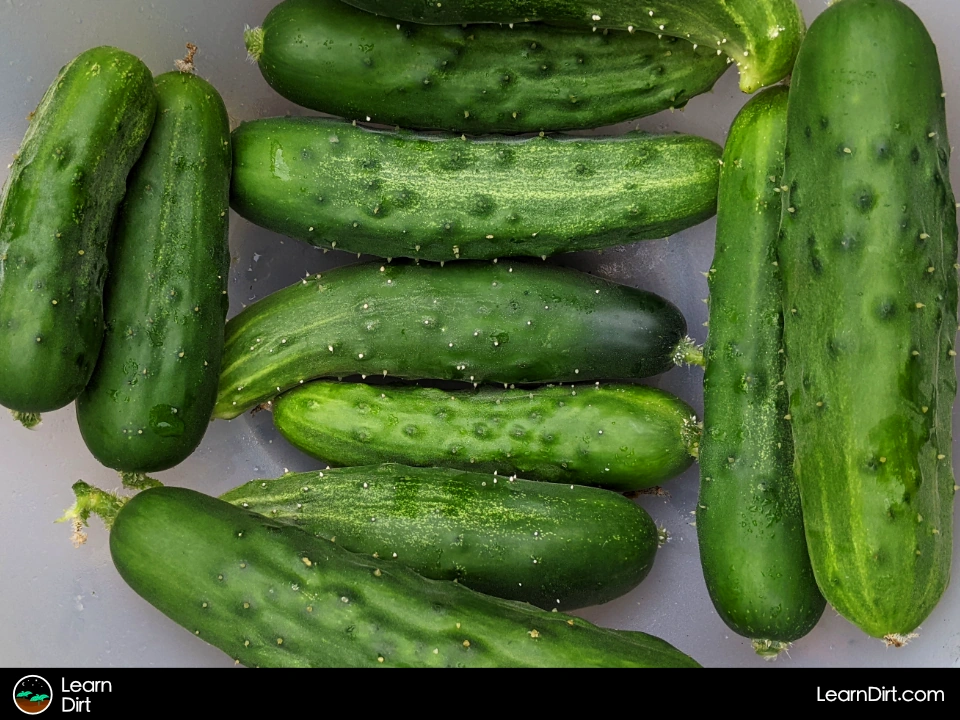
Leggy Cucumber Seedlings
Cucumbers like a good amount of sun, so if you're starting them indoors on a window sill or under grow lights that aren't quite strong enough you may get leggy seedlings.
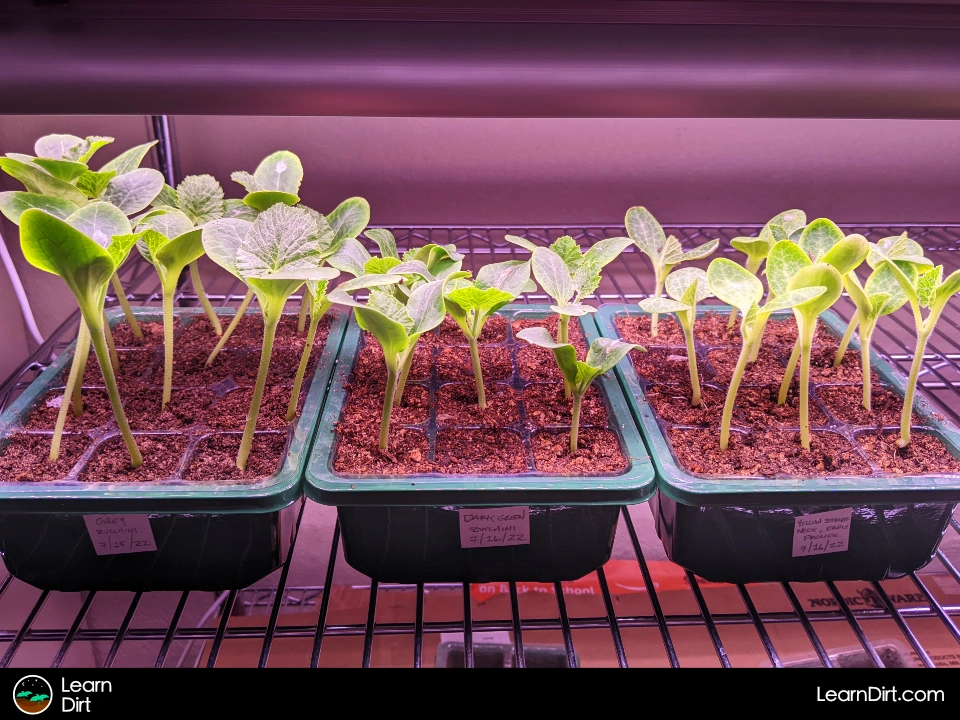
Not to worry, though - if your cucumber seedlings end up leggy from lack of light during their first couple weeks, You can always bury them deeper when transplanting without any risk of smothering them.
Thinning Cucumber Seedlings
If you sowed more cuke seeds than you need, you'll want to thin them out early. Because they grow so quick, they'll fight over nutrients, space, and sunlight.
Thin out the weaker seedlings in the first 2-4 weeks after planting so the most prolific can flourish.
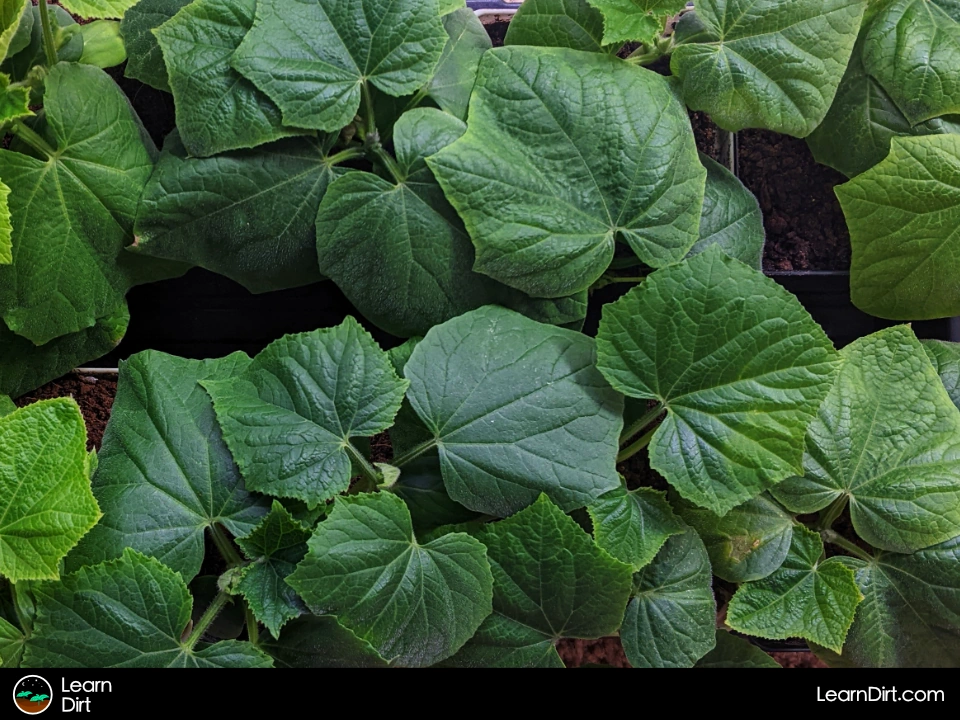
Transplanting Cucumbers
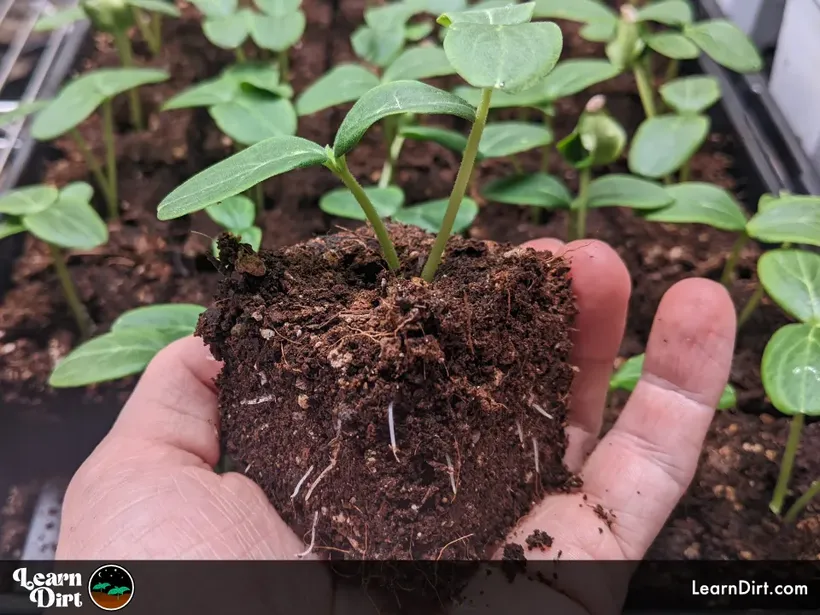
Can Cucumbers Be Transplanted?
Cucumbers are a great candidate for transplant. While they can be a bit sensitive early on, they transplant easily enough with just a bit of care.
Cukes grow quickly from seed, ond starting them early indoors or in a greenhouse can help you get a jump on the season.
When to Transplant Cucumber Seedlings
Where I live in the Sonoran Desert, cucumbers grow during the shoulder seasons (spring and autumn) when temps are not summer inferno nor chilly winter.
In more temperate regions, cucumbers grow in the summer.
When to transplant cucumbers seedlings depends on where you grow and you'll want to reference local grow guides where possible.
In general, what they're looking for is a long warm season - not too cold and not too hot. Frost will kill cucumbers, as will excessive heat and drought.
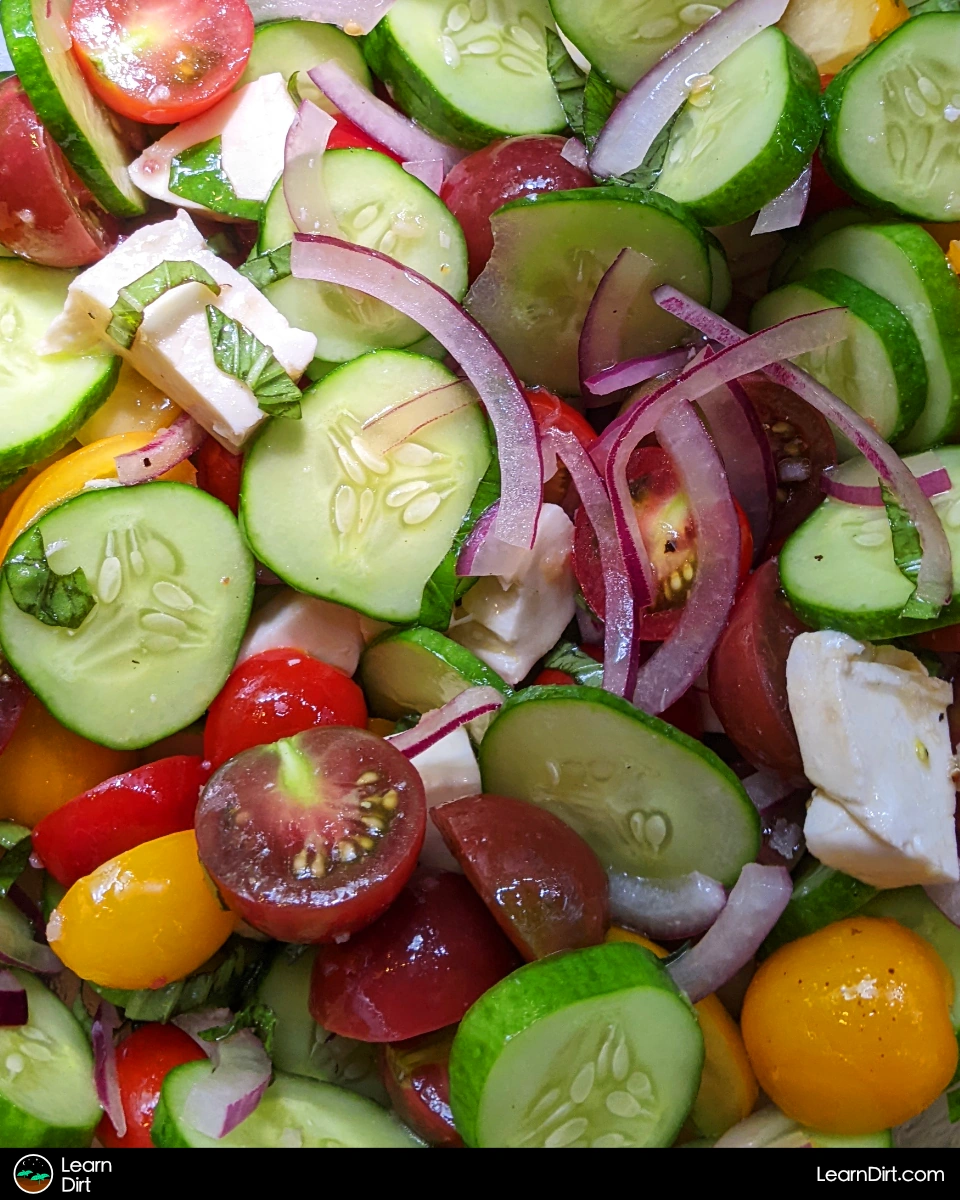
How to Transplant Cucumbers
Once your seedling are big enough and the outdoor temperature is suitable for them in your garden, it's time to transplant your cucumbers.
Let's look at how it's done:
How Deep to Plant Cucumber Plants
Cucumbers are one of a number of plants which will tolerate (and even prefer) to be transplanted deeper than they were originally planted.
This is because their stems are capable of sprouting new roots wherever they contact the soil.
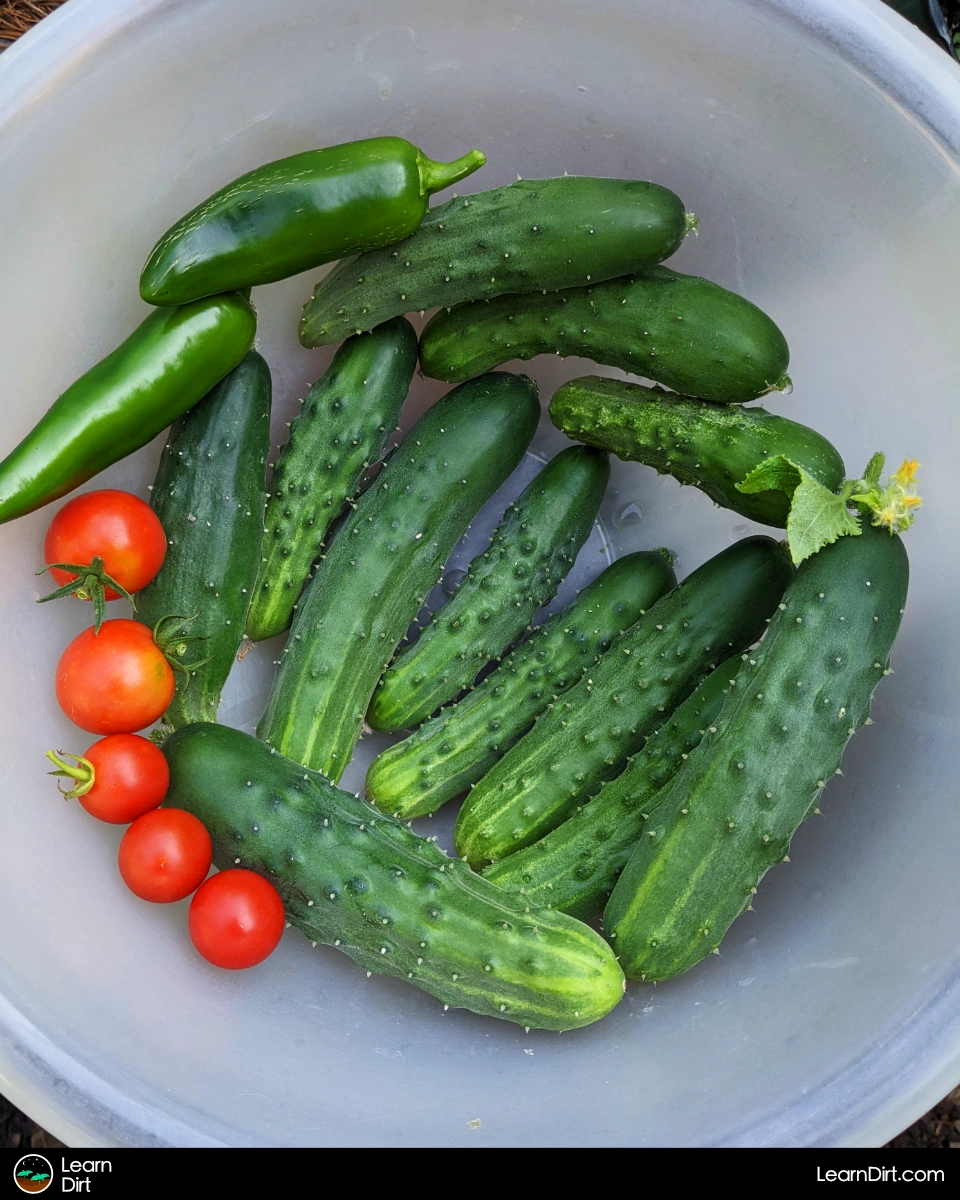
To read about burying plants deeper during transplant, check out our article on burying plant stems.
How Far Apart to Plant Cucumbers
Spacing is always dependent on the availability of nutrients in your soil, how sunny your climate is, as well as the propensity for powdery mildew on overcrowded leaves in wet humid climates.
Most conventional advice suggests about 1ft (~30cm) spacing between plants along a trellis, and 2-3ft (~1m) spacing between trellises.
Dig Cool Merch?
Personally I ignore all spacing advice and rely on the high nutrient density of my soil, abundant sunshine, and lack of any powdery mildew concern in the desert where I live to pack in the cukes like crazy.
Soil quality is almost always the primary bottleneck for tight plant spacing, so if you've improved your soil significantly you might try packing plants in like sardines and let them figure it out themselves.
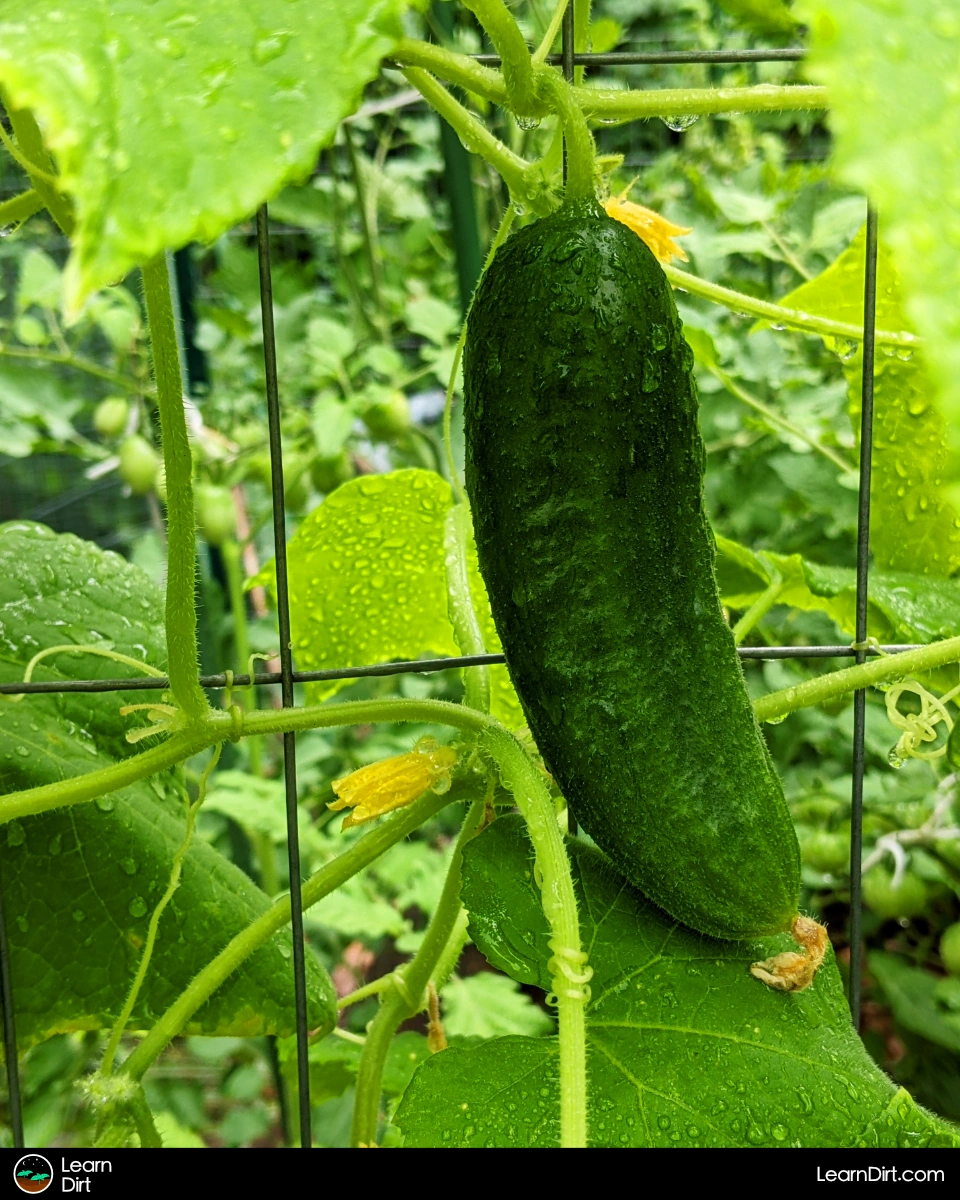
The fastest way to learn what spacing plants can tolerate in your garden is to push the limit and see what happens!
Cucumber Transplant Shock
Transplant shock for plants is like culture shock for humans - a new environment that's unfamiliar and takes time to adjust to.
Your cucumbers may experience transplant shock when you up-pot them, or when you move them out into the garden if they were raised indoors or in a greenhouse.
Compounding the shock of being moved to a new environment is often the trauma that their roots suffer when being squeezed out of a container or seedling tray, and having their roots tousled if they were root-bound.
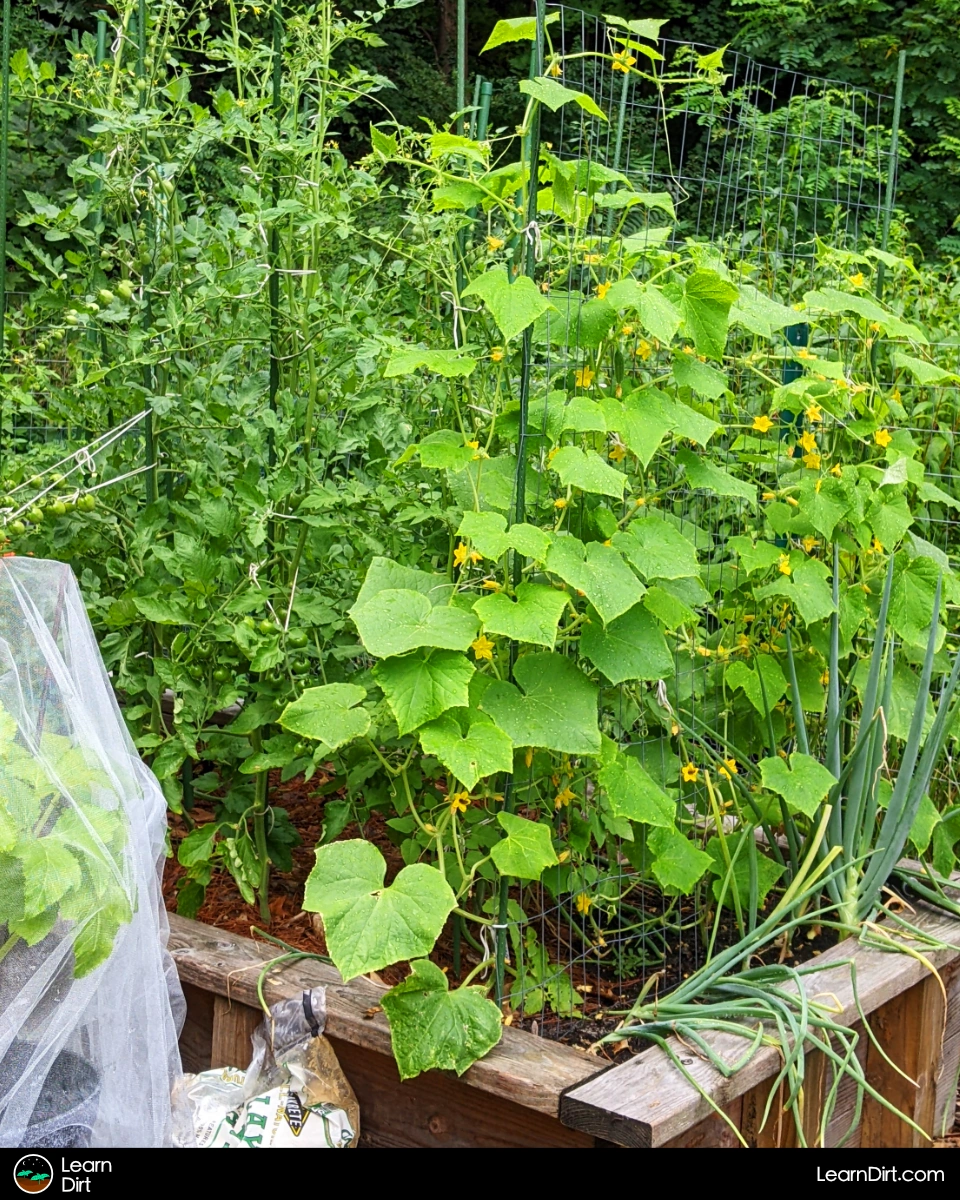
I take a 2-pronged approach to avoiding transplant shock for my cucumbers:
(click on the links above to read about each technique to minimize transplant shock for your cukes)
How to Grow Cucumbers in Pots
You can grow cucumbers in pots successfully, but remember: they are a pretty big plant with robust root systems and grow quickly.
How Big a Pot Do Cucumbers Need?
Many folks have success with growing cukes in buckets, grow bags, or plastic totes.
These give you the flexibility of pots, but with a larger volume for less money.
Aim for at least 5 gallons of soil for 1 or 2 cucumber plants. You can adjust this a bit if the variety you choose to grow is a larger or smaller plant than average.
You could probably get away with a 3-gallon if you don't mind feeding supplemental nutrients frequently, but the roots will be cramped at that size and might inhibit growth somewhat.
Using a Trellis for Cucumbers
Cucumbers are great climbers, with tendrils that grab hold and wrap around anything and everything the can get their "hands" on.
Because of this penchant for climbing, and the space-saving nature of vertical growing, most gardeners use trellises for their cucumbers.
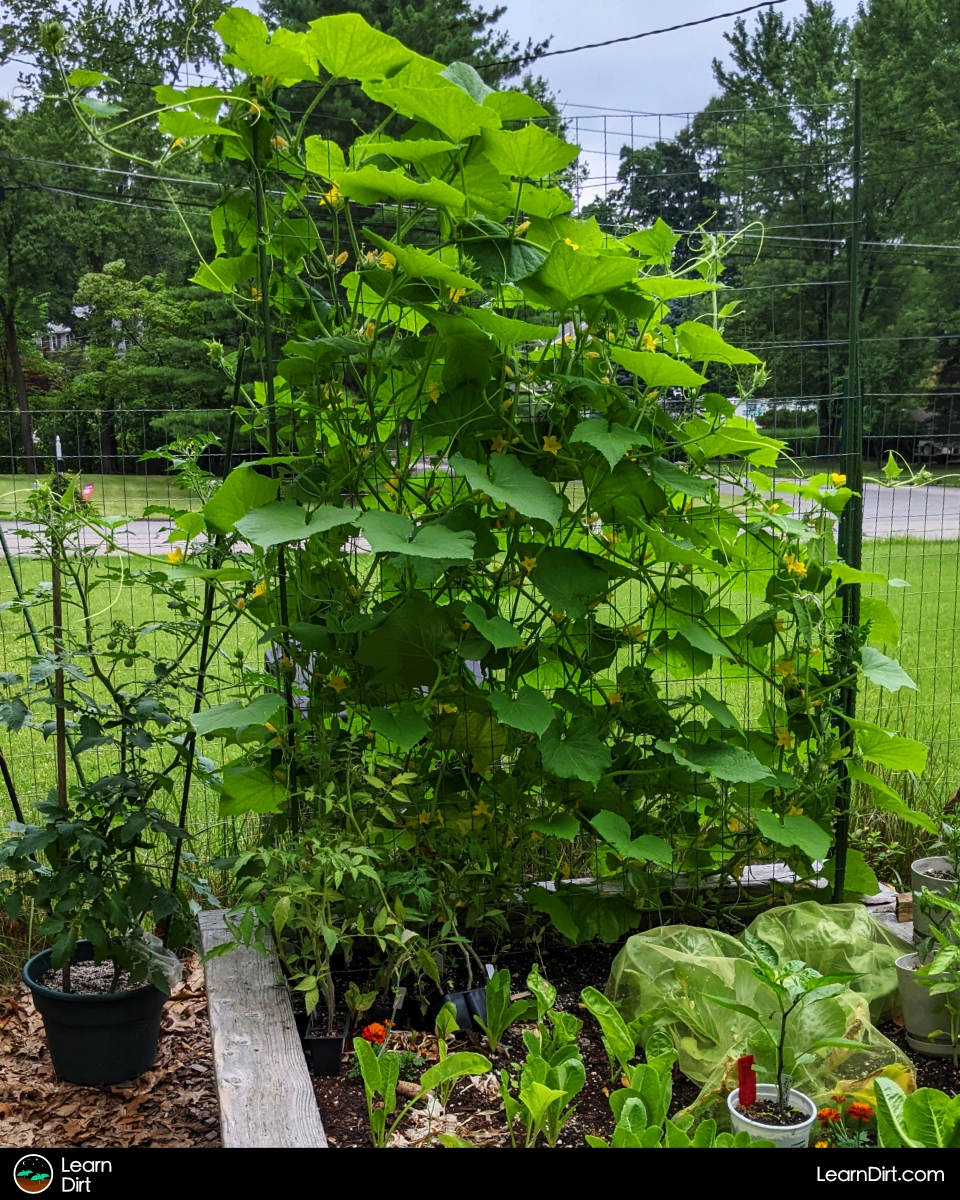
Let's look at how exactly to trellis these vertically-adept cucurbits:
How Do You Trellis Cucumbers
It's fascinating to see timelapse videos of cucumbers - their tendrils slowly revolve around in a ciriclar motion, feeling out for anything they can grab hold of.
Once they find something like a garden trellis (or a tall sturdy plant) they begin reaching in that driection with more tendrils and wrap around whatever will hold them.
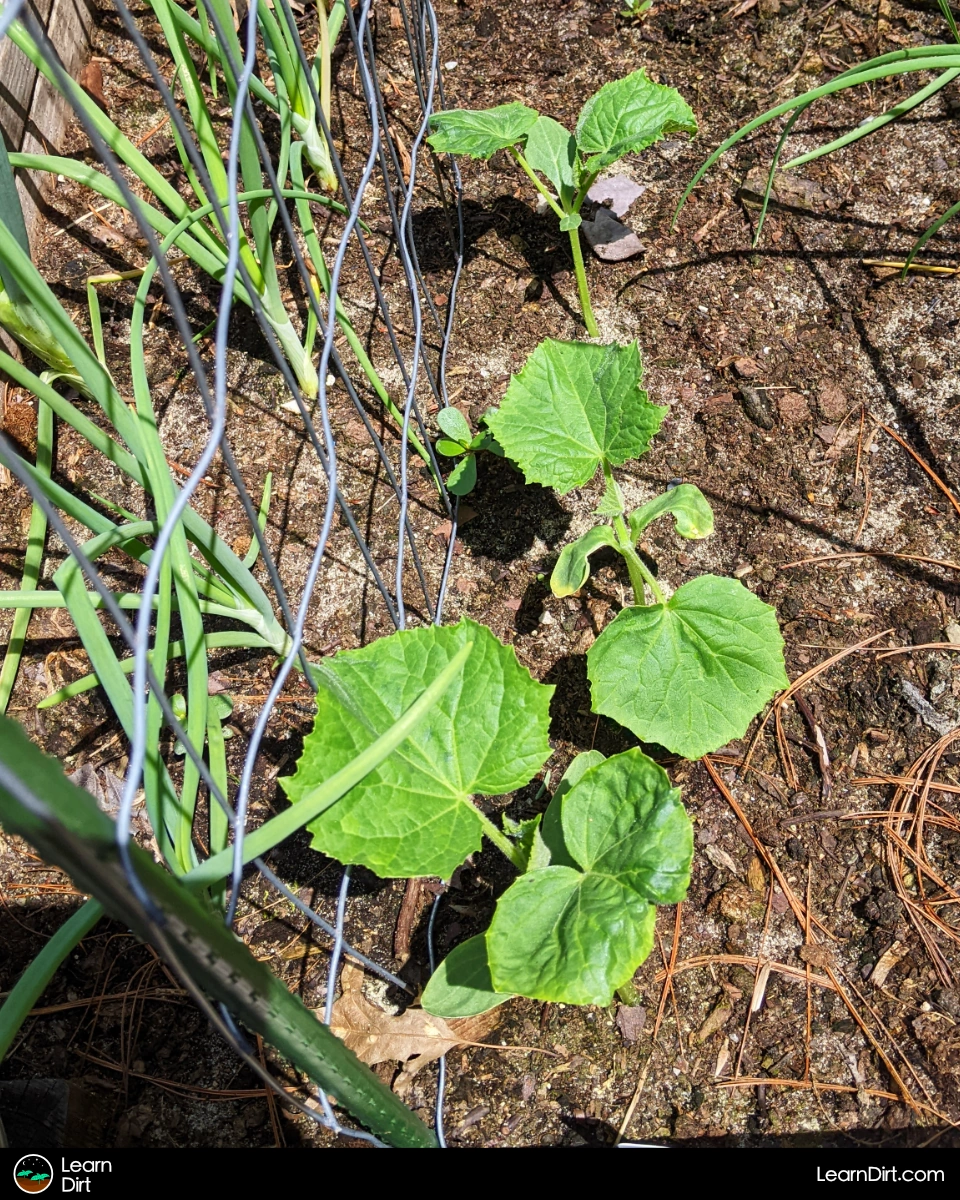
As long as you plant your cukes near the base of a garden trellis, they will find it on their own and won't need your help at all to latch on. Just let them find it and pull themselves up without intervention.
Take a close look at the following photo, and you'll see the tendrils on these cucumber vines grabbing hold of the trellis.
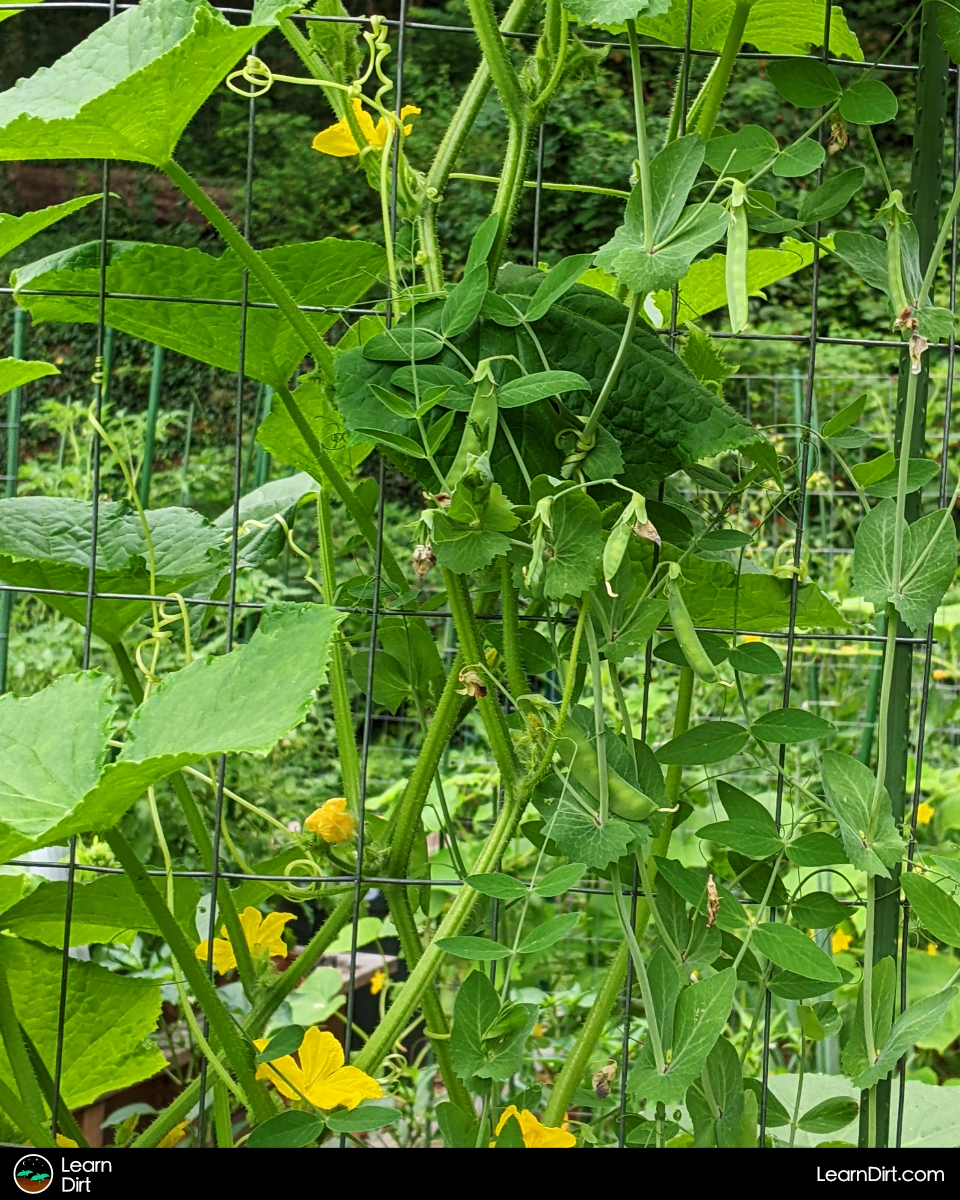
How Big Should a Cucumber Trellis Be?
This depends on your variety, with some cucumber vines staying a short 3ft (.9m) and others stretching up to 6ft (1.8m).
On average, though, give your cucumbers a 6ft (1.8m) trellis if you're not sure how tall they'll get. That will cover your bases for just about any cuke variety.
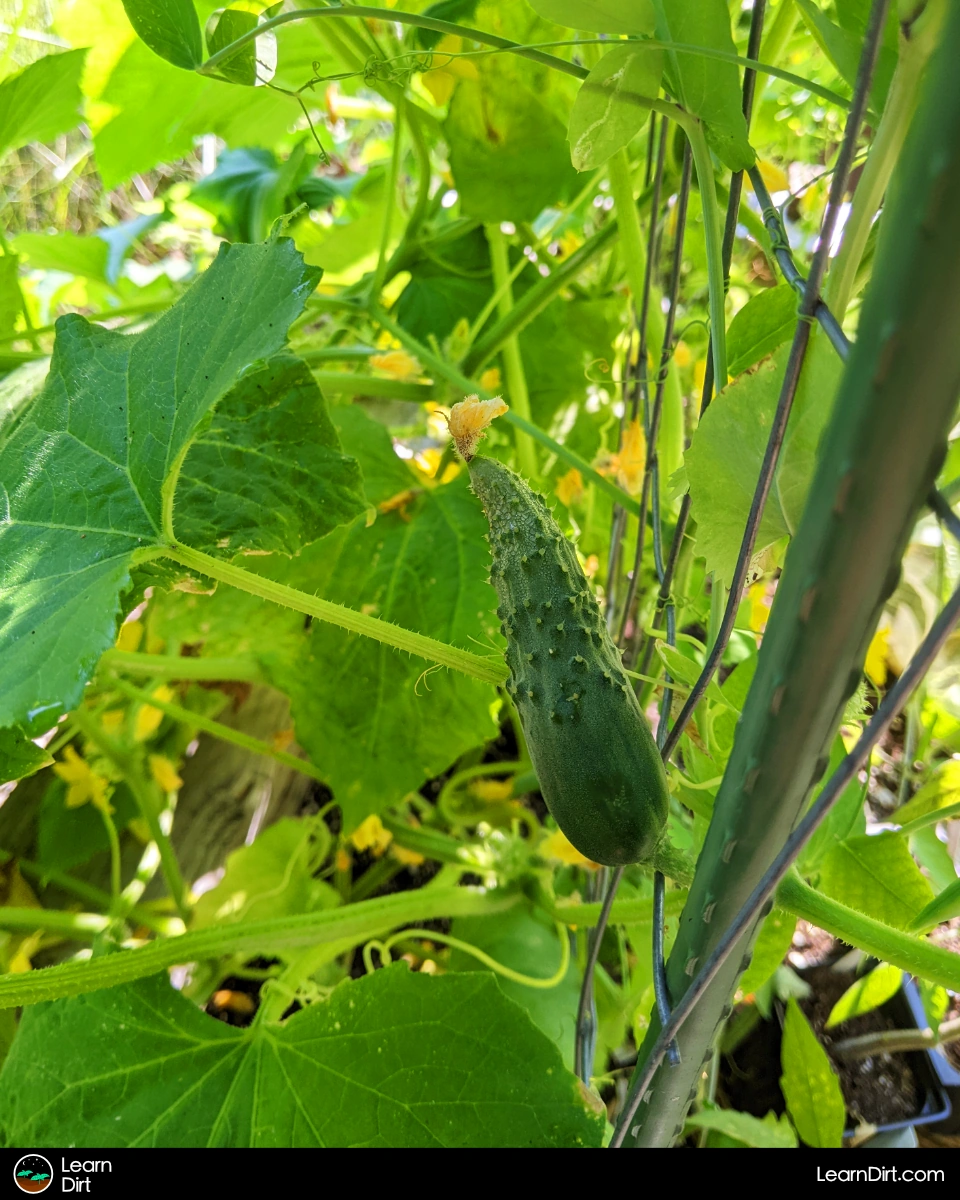
Materials Needed for a Cucumber Trellis
You can use just about anything to trellis your cucumbers, and I encourage you to get creative with it.
Here are some ideas if you want to buy supplies for it (you only need a couple items on this list, not all of them):
- T-Posts
- U-Channel Fence Posts
- Green garden stakes
- Welded Wire Fencing
- 3.5-inch polyester trellis netting
- 7ft Cucumber Trellis Arch
- Fence Post Driver
- Zip Ties
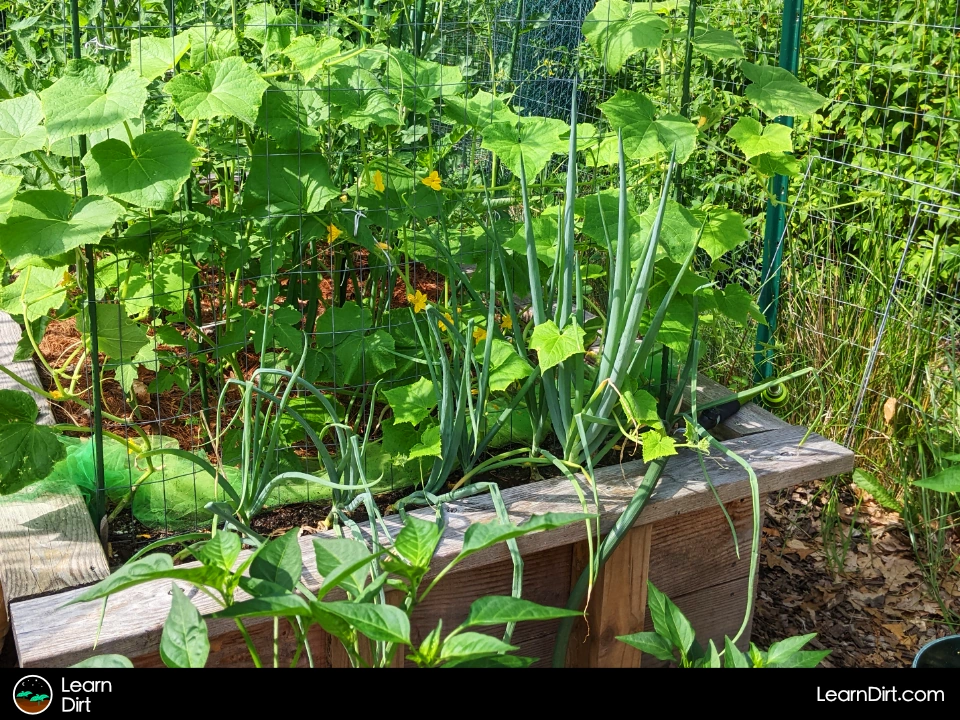
Fertilizing Cucumbers
Cucumbers are moderate feeders, and need a nutrient profile and fertility level it their soil similar to that for tomatoes.
Give them enough nitrogen early on to produce vines and leaves, and then switch to moderate phosphorus and high potassium later on for flowering and fruiting (check out our nutrient chart for some good sources of these.)
Ensure that your soil has a moderate amount of calcium to avoid blossom end rot, and magnesium to go with it.

In organic systems, nutrients break down slowly (unless they're liquid like compost tea or FPJ/FFJ) so it's more about building healthy soil ahead of time than about anything you add while the cucumbers are growing.
Check out our section on soil-building and nutrients to learn how to get everything you need into your soil before you start growing cucumbers so you don't have to worry about doing anything other than feeding your soil.
(or just buy a bag of this, sprinkle some onto your soil or mix it in, and water it.)
Common Cucumber Pests
No garden veggie comes without its share of pests which target it, and cucumbers are no exception.
We always say that if something isn't eating your garden, then it's not part of the ecosystem.
Rather than strive for an impossible standard of zero pests within organic gardens, we aim for a balanced ecosystem. One where where pest populations exist, but are rarely-if-ever out of control.
Encouraging biodiversity and providing food and habitat for beneficial insects and predators is the best way to accomplish this.
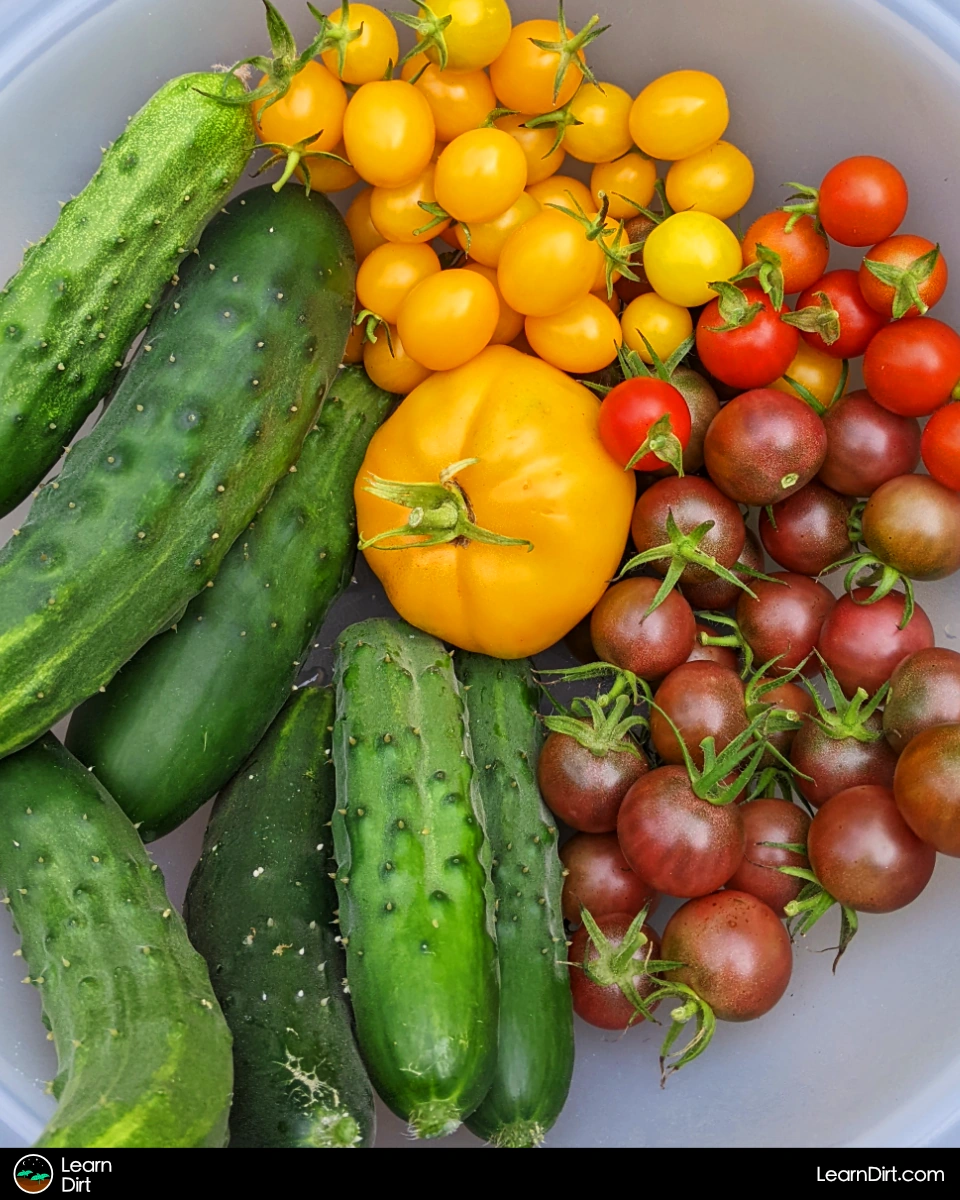
Let's look at some common cucumber pests, and what eats them:
Cucumber Beetles
Cucumber beetles, as you may guess by their name, are a major pest for cukes.
There are striped ones and there are spotted ones, and both are an issue for cucumbers.
The primary concern with these bugs is them spreading bacterial wilt, an infection caused by the Erwinia tracheiphilia bacteria to which there is no known cure.
Cucumber beetles chew on cucumber fruit, leaves, flowers, spread this bacteria, and then your cucumbers wilt and die.
Check out are article on dealing with cucumber beetles.
Squash Vine Borer
While cucumbers are vines in the same family as squash (Cucurbitaceae), you'll be relieved to hear that they are almost never targeted by squash vine borers.
It's not completely unheard of, but from my research it seems to happen so rarely that vine borers are just not an issue for cucumbers.
FAQs
How Long to Grow Cucumbers From Seed?
From seed to harvest, you're looking at around 2 months (depending on variety).
Some compact varieties like Bush Pickle and Titus can go from seed to harvest in just 45 days while slower varieties like Lemon Cukes or Marketmore 76 may take 65 to 70 days - so be sure to read the packet if you're concerned about timing.

How Big Do Cucumber Vines Get?
Cucumber vines grow from 3ft (.9m) to 6ft (1.8m) in length, on average.
Some varieties may fall outside this range, so be sure to check your seed packets and be sure your trellis is big enough before planting.
How Deep Do Cucumber Roots Grow?
Cucumbers have shallow roots, growing down about 1 ft (0.3 m) deep and then spreading out laterally.
This shallow root system means they prefer frequent watering and don't tolerate drought well.
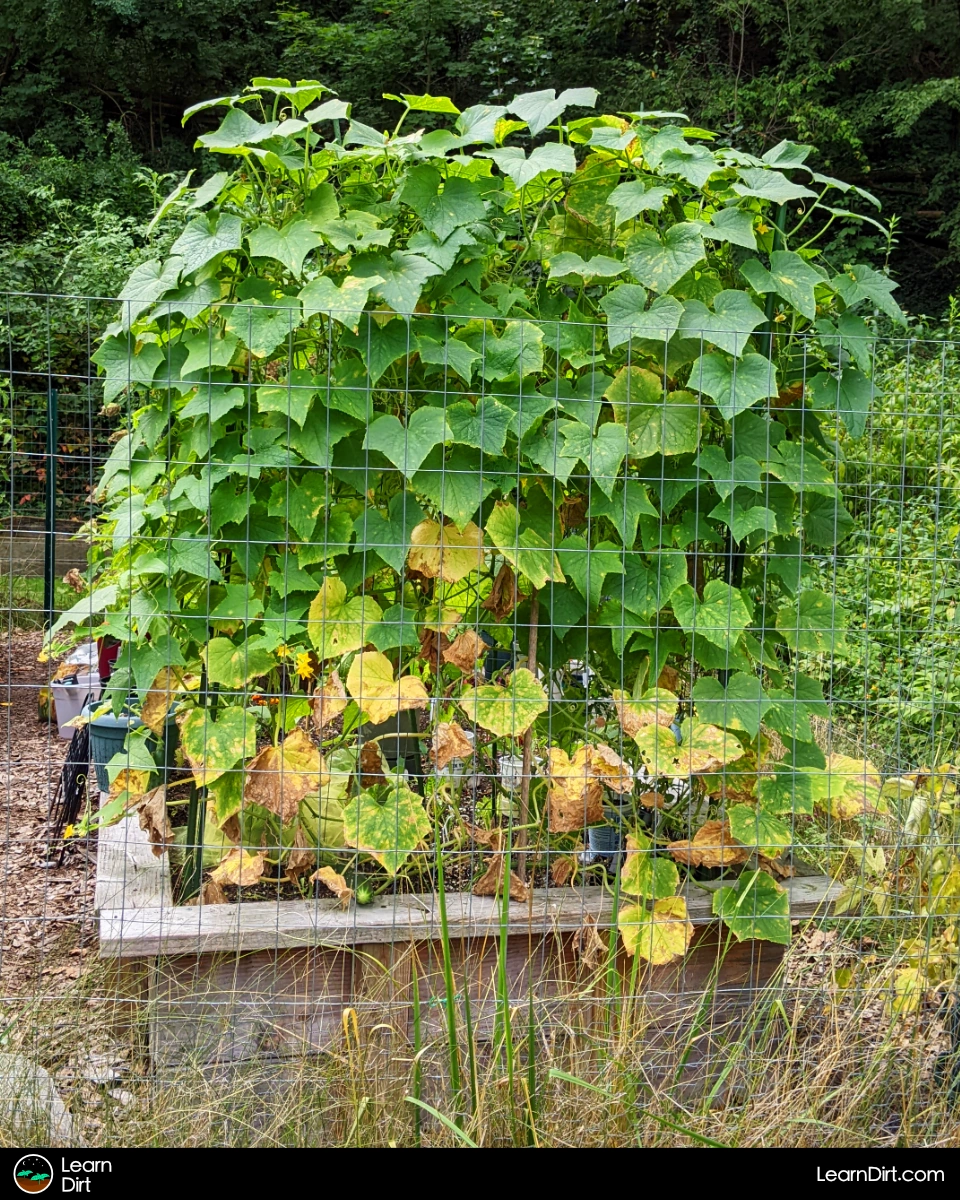
Shoutout to my wonderful Mom, who supplied many of the photos for this article and others straight from her awesome garden 🌱 and for inspiring me to get into gardening in the first place! 😊
That's all for now, thanks for reading!
If you have any questions, comments, or would like to connect with fellow gardeners, head on over to the forum and post there.

![Black Dirt Live Again [Purple]](/media/product_images/black-dirt-live-again-[purple]_sticker_260x260.png)


